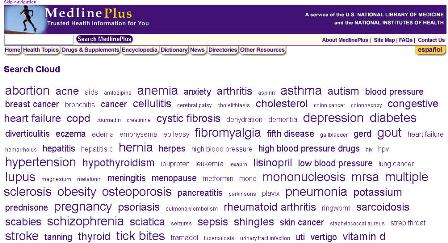
A new application for iPhone allows users to access the database of the National Library of Medicine and National Institutes of Health which holds the results of and information pertaining to more than 71,500 clinical trials.
ACCESS NOW: iClinical Trials
Of course, there is always clinicaltrials.gov if you don’t have an iPhone.
Read more: “Ivor Kovic, M.D. ?é?? Blog Archive ?é?? NIH Database More Accessible to iPhone Users” – http://ivor-kovic.com/blog/?p=419#ixzz0EqGkrQSH&A
Just in time for Mental Health Month comes PsychiatryOnline.com’s Book of the Month for May: Yager & Power’s Clinical Manual of Eating Disorders.
ACCESS NOW: Clinical Manual of Eating Disorders
Clinical Manual of Eating Disorders provides sound therapeutic advice based on current research and clinical practice. It includes detailed discussions of various aspects of assessment and treatment, featuring up-to-date evidence- and consensus-based information. Ranging from the determination of initial treatment approaches to problems posed by unique groups of patients, it marks the first APPI volume specifically directed toward the clinical management of patients with eating disorders-and the first book to focus squarely on what psychiatrists need to know about the clinical assessment and management of patients with anorexia nervosa, bulimia nervosa, binge eating disorders, and obesity.
You can access the Book of the Month from the home page, at www.PsychiatryOnline.com. You’ll have access to Clinical Manual of Eating Disorders as a PDF download for the month of May.
Off campus? Use this link: http://0-www.psychiatryonline.com.innopac.lsuhsc.edu/
Earlier today, two LSUHSC physicians were featured in a Live Chat on NOLA.com regarding Swine Flu. Fred Lopez & James Aiken answered questions from participants for about an hour starting at 12 noon.
Louisiana is clear for the moment, but human cases of swine influenza A (H1N1) virus infection have been identified in the United States. The Centers for Disease Control have created a Swine Influenza (Flu) page at http://www.cdc.gov/swineflu/index.htm
It includes incidence of U.S. Swine Flu Infection, currently at 20 cases in California, Kansas, Ohio, Texas and New York City.
More from CDC:
Interim CDC Guidance for Nonpharmaceutical Community Mitigation in Response to Human Infections with Swine Influenza (H1N1) Virus: http://www.cdc.gov/swineflu/mitigation.htm
Guidance for Clinicians & Public Health Professionals: http://www.cdc.gov/swineflu/guidance/
For international information & global statistics, see the the World Health Organization’s Swine flu page:
http://www.who.int/csr/disease/swineflu/en/index.html
For folks in Louisiana, the State Dept. of Health and Hospitals encourages “Aggressive Prevention” Against Swine Flu:
http://wwwprd.doa.louisiana.gov/LaNews/PublicPages/Dsp_PressRelease_Display.cfm?PressReleaseID=2019&Rec_ID=0
The White House also issued a press briefing on Swine Influenza:
http://www.whitehouse.gov/the_press_office/Press-Briefing-On-Swine-Influenza-4/26/09/
A recent inquiry to Blake Pontchartrain, New Orleans Know-It-All, revealed a very interesting link between New Orleans and Medical History.
According to Blake, “The last house standing at 1032 St. Charles Avenue. . . was once the office of Dr. Elizabeth Cohen, the first woman to practice medicine in New Orleans.”
The historic building now serves as Circle Bar.
Dr. Cohen was not only the first woman to practice medicine in New Orleans, but also the first female physician licensed to practice medicine in Louisiana.
The life of Dr. Elizabeth Magnus Cohen is one with many challenges and triumphs that not only impacted the history of New Orleans, but the role of women in medicine as well.


http://www.nlm.nih.gov/medlineplus/cloud.html
It just got a little easier to find out what consumer health topics are currently popular with patients. MedlinePlus, your number one authority from the NIH on patient health, just released a search cloud.
The search terms appear in alphabetical order, and their size represents their relative frequency. The bigger the term, the more often it is searched by people who visit MedlinePlus. A term’s exact ranking is found by placing your cursor over the term, and you can click on any term in the search cloud to conduct a search for that term in MedlinePlus.
Anyone who’s been on a camping trip lately can sympathize with why tick bites are so popular right now.
As part of National Environmental Education Week and Earth Day, the National Library of Medicine is promoting its toxicology resources. These resources include: ToxMAP, ToxTown, ToxMystery, MedlinePlus, Household Products Database, and Hazardous Substances Data Bank (HSDB). Several of these resources are part of TOXNET which provides access a host of information related to toxicology, hazardous chemicals, and environmental health. For more information on Environmental Health and Toxicology, check out the Special Information Services page at NLM.
April is indeed a busy month, adding?é?áAlcohol Awareness Month?é?áto the list?é?áof health observences.
Drinking one glass of wine per day has been clinically proven to provide health benefits. But what are the risks of drinking more than one glass on the weekend?
Brush up on facts about alcohol to help keep you and your loved ones safe.
Also, learn where Louisiana stands in drunk driving statistics.

April is a popular month for health observances, including National Minority Health Awareness Month sponsored by the US Department of Health and Hospitals Office of Minority Health. Preconception is the theme for 2009 with the slogan “Ordinary couples don?óÔé¼Ôäót plan their pregnancies. Be extraordinary!”

National Minority Health Month
Exam Master, a FREE USMLE testbank for LSUHSC students, announces a completely revised USMLE Step 1 Practice Exam. A wise L2 knows, you can never practice enough for this! First time users of ExamMaster will need to create a username and password:
http://www.exammaster2.com/wdsentry/lsuhsc.htm
More information
April is STD awareness month! That?óÔé¼Ôäós Sexually Transmitted Diseases. The CDC estimates that there are approximately 19 million new cases of STDs each year in the United States, almost half of them among young people ages 15 to 24.
Let?óÔé¼Ôäós look at how Louisiana is doing. (Reports from the CDC – STD Surveillance, 2007)
Chlamydia ?óÔé¼ÔÇØ Reported cases and ranked by rates: United States, 2007
1 Mississippi: 21,686 Cases & a rate of 745.1 per 100,000 Population
2 Alaska:
3 South Carolina:
4 Alabama:
5 New Mexico:
6 Georgia:
7 Louisiana: 19,362 Cases & a rate of 451.6 per 100,000 Population
8 Tennessee:
9 Hawaii:
10 Illinois:
Gonorrhea ?óÔé¼ÔÇØ Reported cases and ranked by rates: United States, 2007
1 Mississippi: 8,314 Cases & a rate of 285.7 per 100,000 Population
2 Louisiana: 11,137 Cases & a rate of 259.7 per 100,000 Population
3 South Carolina:
4 Alabama:
5 Georgia:
Primary and secondary syphilis ?óÔé¼ÔÇØ Reported cases and ranked by rates: United States, 2007
1 Louisiana: 533 Cases & a rate of 12.4 per 100,000 Population
2 Alabama: 380 Cases & a rate of 8.3 per 100,000
3 Georgia:
4 Maryland:
5 Tennessee:
Did you know. . .
?óÔé¼?ó More than 98, 000 people are in need of an organ for transplant.
?óÔé¼?ó In 2007, nationally, 52,869 people were added to the organ waiting list. 905 of these cases were in Louisiana.
?óÔé¼?ó One organ donor has the power to save up to nine lives.
More interesting statistics are available.
Organ donation and procurement can be a confusing and overhwhelming topic so take a minute and learn the facts. The best way to raise awareness about organ donation is to talk about it with others.
Louisiana hospitals are setting a great example by jumping on board to increase Louisiana?óÔé¼Ôäós donor registry by the end of 2009.
Join Louisiana in making an effort to save a life! It’s easy.
The new Federal Tobacco Tax goes into effect today. It will cost smokers over $1 more per pack as of today. In response cessation hotlines are hearing from smokers in record numbers. So if you want to quit and can’t get through on the phone, try one of these websites for assistance:
Louisiana Campaign for Tobacco Free Living – http://www.tobaccofreeliving.org/home/
Smokefree.gov – http://smokefree.gov/
Tobacco Cessation from the Surgeon General – http://surgeongeneral.gov/tobacco/
Healthy Youth! from the Centers of Disease Control – http://cdc.gov/healthyyouth/tobacco/index.htm
Good luck!
March 24th is World TB Day. Although TB rates continue to decline in the United States (according to the CDC), the pace of that decline is slowing. Louisiana continues to have a higher than average number of cases. And while it didn’t rate a special Google logo, World TB day is featured from their search page.
Medlineplus.gov, the National Library of Medicine‘s consumer health information website, has created a tutorial on medical terms to assist consumers in understanding and using medical language.

 myLSUHSC
myLSUHSC




